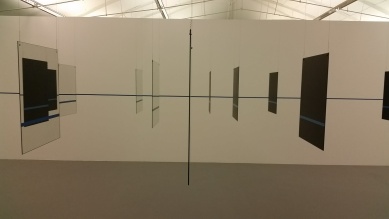Edward Krasiński, Tate Liverpool, untuil 5th March 2017, £11 (includes entry to Yves Klein)
Who to choose as a partner artist for Yves Klein, then? It had to be somebody who shares his abstract principles, who believes that art is more about the experience than the object. Tate have decided that this is a good chance to make the world more familiar with the work of Polish artist Edward Krasiński. It’s a good choice – there’s lots of comparisons and contrasts with Klein, and his work is more than strong enough to stand as an exhibition on its own.
To avoid getting quickly bogged down in explaining what the art here means, let me start by saying that Krasiński’s art is fun to be around. From the opening Composition(s) in Space to the Interventions, it keeps you engaged and entertained. With this in mind don’t try and search for a meaning in an individual artwork, because you won’t find it. They are just intended to be – and what’s wrong with that?

Compositions in Space, designed to be seen as a group and with their shadows.
Krasiński was inspired by surrealism and constructivism, and those influences are quite clear in the early artworks of this show. It’s the form these pieces take that matters, how they sit or hang in their place. It’s the space they occupy that Krasiński is exploring here – how the light and shadows interplay around them, to affect how we experience them.
The point strikes me as being to disrupt our everyday experience of things, to be something that has makes you focus on the existence of the object in their current space and time. Each of these artworks was clearly designed to be exhibited in an extremely particular environment which Tate have, to the best of their abilities, recreated. You feel like you’re probably missing out on something of the original, but there’s still a sense of what they mean. One section, for example, recreates a 1968 exhibition in which many close pedestals were linked by wires. Tate has decided that having a room full of pull-and-trip hazards may not be the best idea, so no wires. A shame, but the closeness of the pedestals still makes you very aware of the space the art occupies, of it being there. And actually, the cut-off wires present their own question about why an artwork has to be connected to anything at all.
Another feeling that connects many of Krasiński’s works is a sense of dynamism. Nowhere is this clearer than at the start of the Interventions series. Started in the early 1970’s and continued right into the 80’s, these are works connected by a line of blue tape which runs not only between, but across each piece. You might think that sounds gimmicky, but I had two reasons for liking it. The first is that it plays not only with the space of each piece, but also its reality. A real pipe looks flat; a 2D painting plays tricks with your perception; they’re all part of something much bigger.

The lines of these Interventions are fun and fast.
That something, the second reason I like this series, is because that single blue line feels like it’s pulling you around the room at pace. I said before there’s not much point in contemplating single artworks: here, there’s not the time either. Your eyes are constantly drawn to what’s coming next. Over paintings, down a corridor, round the corner – you go wherever the line takes you. I know that all exhibitions are what you might call a “journey through art”, but the Interventions actually feel like a very physical journey.
 You end up at a set of mirrors, marked by the blue line, although naturally less connected. More than just providing an excellent Instagram opportunity, these mirrors are the perfect culmination of everything I felt this exhibition is trying to say about Krasiński. They hang in their space, unfixed and continuously moving. Being mirrors, they make you ever so aware of your place as the viewer. They’re black on the other side, which changes your perspective of the piece. But above all, as I started this post by saying, they’re enjoyable. They’re easy to appreciate. Sometimes we need to stop thinking so hard, and enjoy the experience. Everything in this gallery suggests that Krasiński thought exactly the same
You end up at a set of mirrors, marked by the blue line, although naturally less connected. More than just providing an excellent Instagram opportunity, these mirrors are the perfect culmination of everything I felt this exhibition is trying to say about Krasiński. They hang in their space, unfixed and continuously moving. Being mirrors, they make you ever so aware of your place as the viewer. They’re black on the other side, which changes your perspective of the piece. But above all, as I started this post by saying, they’re enjoyable. They’re easy to appreciate. Sometimes we need to stop thinking so hard, and enjoy the experience. Everything in this gallery suggests that Krasiński thought exactly the same

1 thought on “Space, shape and intention”